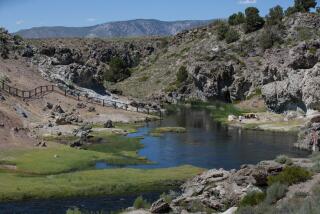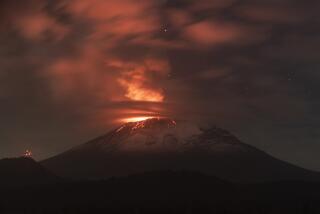Science, Myth Combine to Raise Fears of Volcano Disaster : Mexico: Millions live in ash path of rumbling Popocatepetl. First recorded eruption, in 1519, killed conquistadors who tried to challenge Aztec belief.
- Share via
MEXICO CITY — To the ancient Aztecs, Popocatepetl was the dwelling place for the souls of evil rulers, a towering caldron of smoke and fire, the living symbol of hell on Earth whose fury seemed to presage the great disasters of their era.
To U.S. scientists, the snow-peaked mountain 39 miles southeast of Mexico City has been an extraordinary living laboratory, an active volcano within reach of their research centers and one that many believe could erupt at any moment.
But to the Mexican civil defense authorities struggling Friday to evacuate tens of thousands of people from villages in its shadows, the 17,887-foot volcano has become a potential nightmare.
After two days of watching “Popo,” as the volcano is known, belch black ash and recording seismic rumblings that worry the best volcanologists of Mexico and the United States, authorities were feverishly trying to determine how to limit the disaster if it blows.
The dimensions of the dilemma are in the numbers: More than 20 million people live within a 62-mile radius of Popo’s cone, many in flimsy houses in the ash path of the mountain that on a clear day dominates the horizon in one of the most populous cities on the globe.
At greatest risk are the millions of Mexicans whose homes are not likely to withstand the weight of thousands of tons of ash that could rain on the region if Popo does have a major eruption. Expected mudflows from the ice lake in Popo’s cone would wreak even more havoc in an area so densely populated. A smaller number of villagers live at greater risk, directly under the cone. They live in 18 villages and towns now being evacuated to 70 makeshift shelters and disaster relief centers.
Civil defense officials describe the evacuation as a precaution. But by midday Friday, as ash continued to spew from a cone no longer visible through Popo’s grayish-black cloud, officials had managed to relocate more than half of the 75,000 villagers in the highest-risk zone. About 30,000, officials said, refused to leave, not wanting to risk losing their few possessions to looters. But most left. And for many, the reasons were centuries old.
“When Popo speaks,” said one Indian woman making her way to a shelter with a small bundle of clothes, “we must obey.”
It is not science but powerful myths that have struck fear in many residents. With an Indian rebellion in the southern state of Chiapas resurfacing with a vengeance this week, followed by economic turmoil when the government allowed the peso to tumble in value, many see Popo’s rumblings as a modern sign of the mountain’s ability to augur disaster.
“I’m worried about what it could mean for the future,” said Luis Soriano Escobar, a 60-year-old repairman in the town of Amecameca near Popo. For most of his life he has been rescuing climbers and tourists near its peak--feats that have earned him the local Indian nickname Tlaxquiche, or Mountain Animal. “There’s the war in Chiapas. There’s inflation. There could really be something behind all of this. It could be a very bad sign.”
Scientists think so too.
U.S. and Mexican volcano experts--from Mexico City to Buffalo to Arizona to Washington, D.C.--have been studying Popo intensively since, as one put it, “Popo lit up a year ago” with heavy emissions of gases and a number of small earthquakes inside the volcano. And even though volcanologists are the first to admit that theirs is an inexact science, there is a near-unanimity now that the mountain has entered a dangerous phase.
The mountain’s full explosive power has yet to be seen by modern man. Despite 16 eruptions recorded since the Spaniards first landed here in 1519, Popo is not believed to have delivered a really big blast for about 2,000 years.
Can it happen now?
“The bottom line is that, despite the fact that it’s been tame this century, (Mexican authorities) must respect the volcano’s warning,” said Stanley N. Williams, a volcanologist at Arizona State University who visited the mountain last summer.
University of Buffalo experts declared Friday that Popo’s current activity resembles that of Mt. St. Helens shortly before its devastating 1980 eruption in Washington state. “The chamber is loaded,” said Michael Sheridan, who chairs the university’s geology department.
Geophysicist Randy White was alarmed by a “harmonic tremor” inside Popo that lasted more than 22 hours this week. The tremor accompanied the explosion of ash; that usually signals the movement of magma, or molten rock, which White said can presage a serious eruption.
The tremor is no longer increasing, said White, who works for the U.S. Geological Survey in Menlo Park. “But still, such a lengthy harmonic tremor is cause for fair concern that something else will happen.”
White and several Mexican scientists also expressed a second, deeper concern. Mexican government inaction on a year-old request to install special seismic equipment at Popo, they said, has left them without key information that would more accurately predict when--or if--Popo may erupt.
“We are not getting good data,” White said, stressing that there are just two seismic monitoring stations near the mountain. The request for a more sophisticated monitoring network by one of Mexico’s top volcanologists, Servando de la Cruz Reyna, is still pending before the government. “As a result . . . we are seeing inconsistent amplitudes of ground shaking at various places. There is about 50 times the difference in readings we should be getting.”
Volcanologists use those seismic readings to detect tremors that are believed to be an important warning sign of an eruption. In recent weeks, Mexican scientists said there have been up to 100 minor quakes inside Popo every day.
Based on available data, the U.S. volcano experts agreed that no big eruption is likely for four to eight weeks. They also stressed that, given Popo’s 20th-Century performance, its eruption is unlikely to break world records. But they all cautioned that Popo’s history could repeat itself.
The first eruption recorded at Popo was in 1519. It served as the basis for Aztec beliefs about the mountain. That was the year Spanish explorer Hernando Cortes landed and began to conquer the Aztec empire. According to Aztec historians, Cortes ordered his men to climb Popo to prove to the Aztecs that it was not, as they believed, a sacred land of evil souls where no man could tread.
Cortes’ men never reached the summit. The volcano erupted, showering the conquistadors with what historians called a torrent of stones and ice that forced them to turn back.
Another series of eruptions from 1590 to 1592 coincided with epidemics of smallpox, measles and flu that reduced the Aztec population to its smallest numbers ever. Popo blew again in 1720--the year of a great drought in central Mexico. Two years of additional eruptions beginning in 1802 were seen as omens of the 1810 war of independence against the European colonizers. And the last major period of eruptions, from 1919 until 1927, began about the time Mexico’s legendary freedom fighter Emiliano Zapata died.
Experts are quick to point out that all 16 of the recorded eruptions in the last four centuries registered between 1 and 3 on an official volcano index that ranges up to 8, with each number representing 10 times more power than the previous number. By comparison, the Mt. Pinatubo eruption that devastated the Philippine island of Luzon in 1991 was classified as a 6. The great 1815 Tambora eruption in the Indonesian archipelago was a 7. And the eruption of Mt. St. Helens was a 5, 10 times greater than Popo’s worst in 1720.
De la Cruz Reyna has been quoted in recent days as saying Popo’s most recent behavior resembled what presaged a relatively mild eruption in 1921. He suggested the statistics give little cause for great alarm.
“Servando is right about that, based on the 20th-Century eruptions,” said Williams at Arizona State. “But we have to be extremely careful not to assume this will follow that pattern. Popo has been dangerous before the 20th Century, and it could be again.”
And U.S. Geological Survey scientist Michael Sorey had a chilling bottom line on Popo.
“It’s a dangerous volcano,” he said. “It’s been several hundred years since it’s been dangerous, but that’s just yesterday geologically. It’s a volcano that has frequently erupted violently in the past, and it’s to be considered very dangerous now.”
Fineman reported from Mexico City and Reich from Los Angeles.
(BEGIN TEXT OF INFOBOX / INFOGRAPHIC)
Rumblings From Below
Popocatepetl, which means “Smoking Mountain” in the Indian language Nahuatl, was spewing smoke and ash on its southwest side Friday. The volcano is 39 miles southeast of Mexico City.
THE DANGER SIGNALS
Deformation: Signs of bulging caused by molten rock deep in the Earth working its way up into the mountain.
Degassing: A rise of sulfur and carbon dioxide emissions from the crater.
Seismicity: Ground movement or long harmonic tremors, which indicate movement of lava within the mountain.
FACT FILE
Height: 17,887 feet
Last eruption: 1947 (16 eruptions since the year 1519)
Population in area: 20 million within 62-mile radius
HOW THIS TYPE OF VOLCANO FORMS
Popocatepetl is related to the subduction zone where the Pacific and North American tectonic plates meet.
1) Over millions of years, a slab of one tectonic plate dives under another, carrying with it sediments filled with water and minerals.
2) Water and minerals released from the subductive plate rise into hot rocks in the mantle, melting them.
3) Rising magma--lava, gases, ash--is extruded on to the surface through the volcano.
More to Read
Sign up for Essential California
The most important California stories and recommendations in your inbox every morning.
You may occasionally receive promotional content from the Los Angeles Times.










